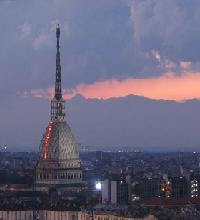
Oggi voglio dedicare un post a Lucento (il quartiere dove sono nato e tuttora vivo) e, più in particolare, alla sua storica Chiesa dei Santi Bernardo e Brigida, protettori del quartiere.
L’origine della parrocchia di Lucento (il cui nome pare derivi da “lucus” = bosco) va ricercata nel lontano 1462. La chiesa costituiva, assieme al castello, il primo nucleo di Lucento. Nel 1578, la Sacra Sindone, proveniente da Chambery, vi sostò per 4 giorni.
L'edificio subì nei secoli quattro successivi ampliamenti. Il restauro e la tinteggiatura del 2001 hanno permesso di riportare la chiesa agli splendori dei colori tradizionali.
Una nota: i quattro numeri a caratteri cubitali “1706” ricordano l’anno della Battaglia di Torino contro gli odiatissimi francesi, i quali furono cacciati grazie anche a Pietro Micca (l’eroe cittadino al quale è dedicata una delle vie più belle del centro), considerato uno dei primi kamikaze dell’Occidente.
"Ma come?" direte voi. "I kamikaze non erano i giapponesi durante la Seconda Guerra Mondiale? E adesso non lo sono i terroristi islamici?"
L’origine della parrocchia di Lucento (il cui nome pare derivi da “lucus” = bosco) va ricercata nel lontano 1462. La chiesa costituiva, assieme al castello, il primo nucleo di Lucento. Nel 1578, la Sacra Sindone, proveniente da Chambery, vi sostò per 4 giorni.
L'edificio subì nei secoli quattro successivi ampliamenti. Il restauro e la tinteggiatura del 2001 hanno permesso di riportare la chiesa agli splendori dei colori tradizionali.
Una nota: i quattro numeri a caratteri cubitali “1706” ricordano l’anno della Battaglia di Torino contro gli odiatissimi francesi, i quali furono cacciati grazie anche a Pietro Micca (l’eroe cittadino al quale è dedicata una delle vie più belle del centro), considerato uno dei primi kamikaze dell’Occidente.
"Ma come?" direte voi. "I kamikaze non erano i giapponesi durante la Seconda Guerra Mondiale? E adesso non lo sono i terroristi islamici?"
No, non stupiamoci di tanto. Pietro Micca attese, nascosto nei sotterranei della mia città, l’arrivo dell’esercito francese e si fece saltare in aria insieme alla polveriera al passaggio delle truppe transalpine.
Today I wish to dedicate a post to Lucento (the suburb where I was born and live still now) and, more particularly, to its ancient St. Bernardo’s and St. Brigida’s Church, the local patron saints.
The origin of the Parish of Lucento (it appears that the name “Lucento” derives from Latin word “lucus” = woods) dates back as early as 1462. The church formed, together with the local castle, the original core around which the suburb would subsequently develop. In 1578, the Holy Shroud was, on its being moved from Chambery (France) to Turin, kept for 4 days at this church.
St. Bernardo’s and St. Brigida’s Church underwent four different extensions during the next centuries. The refurnishing and wall-painting completed in 2001 has given the building the splendour of its traditional brilliant colours
By way of curiosity, the four block-sized numbers “1706” refer to the year of the Battle of Turin against the much-hated French invaders, who were driven out of the city also thanks to the sacrifice of Pietro Micca (a hero of Torinese history) to whom one of the finest downtown streets has been dedicated. Pietro Micca can be considered as one of the earliest Western kamikazes. Quite funny, isn’t it? People think of kamikazes only as the members of the Japanese air force attack corps assigned to make suicidal crashes against foreign targets during World War II. Or as the present-day terrorists (should we really call them this name?) belonging to fundamentalist Muslim organizations.
The origin of the Parish of Lucento (it appears that the name “Lucento” derives from Latin word “lucus” = woods) dates back as early as 1462. The church formed, together with the local castle, the original core around which the suburb would subsequently develop. In 1578, the Holy Shroud was, on its being moved from Chambery (France) to Turin, kept for 4 days at this church.
St. Bernardo’s and St. Brigida’s Church underwent four different extensions during the next centuries. The refurnishing and wall-painting completed in 2001 has given the building the splendour of its traditional brilliant colours
By way of curiosity, the four block-sized numbers “1706” refer to the year of the Battle of Turin against the much-hated French invaders, who were driven out of the city also thanks to the sacrifice of Pietro Micca (a hero of Torinese history) to whom one of the finest downtown streets has been dedicated. Pietro Micca can be considered as one of the earliest Western kamikazes. Quite funny, isn’t it? People think of kamikazes only as the members of the Japanese air force attack corps assigned to make suicidal crashes against foreign targets during World War II. Or as the present-day terrorists (should we really call them this name?) belonging to fundamentalist Muslim organizations.
No, don’t be amazed at this. Pietro Micca hid in the underground passages that ran (and run still today) in the “mysterious subsoil” of Turin. There he waited for the French army to come: he set a powder magazine on fire, thus bursting himself out and slaughtering the French troops walking above.




















2 commenti:
Non sapevo che Pietro Micca era di Lucento. Grande Pietro Micca !!! Scusami ma sono molto nazionalista. Ciao
Ms
Salam,
In effetti Pietro Micca non era di Lucento: era di Sagliano Micca, credo, provincia di Asti (o qualcosa del genere).
Solo che la battaglia del 1706 fu combattuta in un quartiere attiguo al mio (un quartiere che, guarda caso, si chiama Borgo Vittoria). Per tale motivo, il Comune due anni fa ha voluto ricordare il tricentenario. E poi, "contro" i francesi, se non siamo nazionalisti noi piemontesi ...
Ciao
Posta un commento